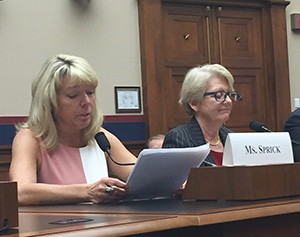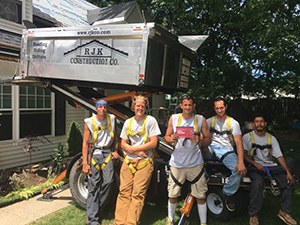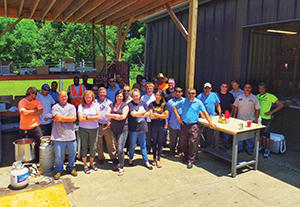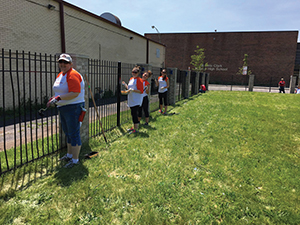OSHA issues workplace injury and illness final rule
The Occupational Safety and Health Administration (OSHA) has issued a final rule to modernize workplace injury and illness data collection to better inform workers, employers and the public about workplace hazards. Under the new rule, employers in high-hazard industries must send OSHA injury and illness data to be posted on OSHA's website.
The Bureau of Labor Statistics reports more than 3 million workers suffer a workplace injury or illness each year. Although OSHA already requires many employers to keep records of injuries and illnesses to help employers and their employees identify hazards, little information about injuries and illnesses that occur at individual workplaces is made available to OSHA or the public. Using data collected under the new rule, OSHA will create the largest publicly available data set for work injuries and illnesses.
Public disclosure of work injury and illness data likely will encourage employers to increase their efforts to prevent workplace injuries and illnesses. Prospective employees will be able to identify workplaces with the lowest risk of injury, so employers that want to hire the best workers will have to make injury prevention a high priority. Access to the data also will enable employers to benchmark their safety and health performance against industry leaders to improve their own safety programs.
"Since high injury rates are a sign of poor management, no employer wants to be seen publicly as operating a dangerous workplace," says David Michaels, assistant secretary of labor for occupational safety and health. "Our new reporting requirements will 'nudge' employers to prevent worker injuries and illnesses to demonstrate to investors, job seekers, customers and the public that they operate safe and well-managed facilities. Access to injury data will also help OSHA better target our compliance assistance and enforcement resources at establishments where workers are at greatest risk, and enable 'big data' researchers to apply their skills to making workplaces safer."
Under the new rule, companies must electronically submit injury and illness information to OSHA. The new requirements take effect Aug. 10 and do not change employers' obligations to complete and retain injury and illness records under the Recording and Reporting Occupational Injuries and Illnesses regulation. OSHA's workplace injury and illness final rule is available at www.federalregister.gov/articles/2016/05/20/2016-11817/improve-tracking-of-workplace-injuries-and-illnesses-correction.
NRCA responds to DOL's overtime pay final rule
NRCA has issued a statement expressing its disappointment with the Department of Labor's (DOL's) final rule regarding overtime pay under the Fair Labor Standards Act. A paraphrased version of NRCA's statement follows:
"The rule is part of [DOL's] efforts to increase middle-class wages. Although this is a laudable goal, NRCA is concerned the new rule will add an additional paperwork burden and increase labor costs for employers while reducing workplace flexibility and pay for some workers. NRCA outlined these concerns in comments filed on the proposed rule in September 2015.
"The new rule is set to go into effect Dec. 1. It will more than double the current salary threshold of workers who are eligible for overtime from $455 per week (or $23,660 per year) to $913 per week (or $47,476 per year). This will affect an estimated 4 million workers who will now receive overtime pay (minimum of 1 1/2 times a worker's salary) after 40 hours worked in a week.
"After the initial increase this year, the threshold will be updated every three years and tied to the 40th percentile of full-time salaried workers in the lowest-wage region of the U.S. (currently the Southeast). This means the next update will take place Jan. 1, 2020.
"NRCA recommends members review the wage structure and classification of their employees to ensure they are complying with the rule and to prepare for potential impacts to their payrolls."
NRCA's full statement is available at www.nrca.net/0516-statement-DOL-FLSA-overtime-pay. A DOL fact sheet about the new rule is available at www.dol.gov/whd/overtime/final2016/overtime-factsheet.htm. To read more about how the rule will affect roofing contractors, see "DOL's revised overtime regulations."
NRCA member testifies to U.S. House about OSHA policies
On May 25, NRCA provided testimony to the U.S. House of Representatives Workforce Protections Subcommittee regarding its concerns about Occupational Safety and Health Administration (OSHA) policies and their effects on workplace safety in the roofing industry. Lisa Sprick, president of NRCA member Sprick Roofing Co. Inc., Corvallis, Ore., testified on NRCA's behalf.

Lisa Sprick, president of Sprick Roofing Co. Inc., Corvallis, Ore. |
"There is great concern within the roofing industry about a number of OSHA regulations and the effects they will have on worker safety and on businesses such as mine," Sprick said. "I am concerned some OSHA regulations and actions could prove to be counterproductive toward making workplaces safer. This would be truly tragic given the inherent danger of roofing work."
In her testimony, Sprick addressed two examples of how NRCA believes recent OSHA regulations are taking the wrong approach to improving workplace safety in the roofing industry, including injury and illness reporting, which requires employers to submit injury and illness records electronically to OSHA to be posted online for public inspection.
"Data will be presented without any meaningful context, which is absolutely critical to understand the information properly," Sprick said of the injury and illness reporting final rule. "Without presenting the whole picture of how certain injuries and illnesses occurred, the information is meaningless, so it is unclear how this information being made public will help advance the cause of improved workplace safety."
Sprick also emphasized the supposed benefits of the rule are speculative and not supported by empirical data to justify the rule's implementation.
In addition, Sprick addressed OSHA's recent efforts to impose federal fall-protection regulations on state-plan states such as Oregon. Sprick and other NRCA members are concerned by OSHA's push to force state-run agencies to adopt federal fall-protection regulations, despite the data showing state-plan rules are more effective for preventing injuries.
"Statistics demonstrate fatality rates in Oregon and California are significantly lower than most states under OSHA's jurisdiction," she said. "Additionally, it should be noted that since OSHA changed the rules for fall protection in 2010, the number of fatal falls nationwide has actually increased."
Data from the Bureau of Labor Statistics show fatal falls have steadily increased each year since OSHA changed the rules for fall protection in 2010. There were 61 fatalities in 2010 and 71 fatalities in 2014.
Sprick said NRCA is ready to work with Congress and OSHA to craft effective safety policies based on sound risk-management principles and reliable data.
Third annual National Roofing Week is a success

RJK Construction Co., Willoughby, Ohio |

RoofCARE, Albuquerque, N.M. |

Baker Roofing Co., Richmond, Va. |

Surface Shield Roofing Co., Honolulu |

NRCA staff |
NRCA members and the roofing industry celebrated National Roofing Week June 5-11.
This year, NRCA encouraged members to participate in a Thunderclap campaign. Thunderclap is a crowdspeaking platform that allows people to Tweet or post a Facebook message at the same time to rise above the noise on social media. On the first day of National Roofing Week, 121 participants shared the same message on their social media accounts: "It's National Roofing Week! Share if you're thankful for the roof over your head! #NationalRoofingWeek." The campaign generated a total social media reach of 124,359 people.
During the week, NRCA members also shared photos of themselves, their employees and their projects on social media as part of NRCA's social media card campaign, and NRCA posted several videos to its social media accounts in celebration of roofing professionals and their important role in communities. Visit NRCA's YouTube channel at www.youtube.com/user/nrcanews and NRCA's Facebook page at www.facebook.com/nrcainfo to view the videos and posts.
The winners of NRCA's third annual Children's Art Contest also were announced. The contest was open to children in grades 1-8 who are relatives of NRCA members and their employees. Fifty-three children submitted illustrations depicting what roofs do. The online voting generated more than 3,000 votes, and the following children were announced as winners: Rocky Benson, Grade 2, grandson of Don Guthrie, president of Wayne's Roofing Inc., Sumner, Wash., won in the Grades 1-2 category; Isabella Jube, Grade 4, daughter of Raphael Jube, director of operations for Ideal Building Solutions, Norcross, Ga., won in the Grades 3-5 category; and Bella Parli, Grade 7, granddaughter of Jack Diamond, owner of A Good Roofer Inc., Lakeside, Calif., won in the Grades 6-8 category. To view the winning artwork, see "A work of art."
NRCA staff also spent time volunteering for two community service projects in the spirit of National Roofing Week. On May 24, nearly two dozen NRCA employees joined volunteers from CNA, Chicago, and Rebuilding Together® at the YouthCAN Center in Chicago for a day of service. The YouthCAN Center provides local youth with a safe place to go after school to receive academic assistance and learn about computer technology, art and music. The center was in serious need of interior and exterior repairs. Volunteers worked together to remove wallpaper, clean light fixtures, clear out a storage closet, organize classroom and office supplies, plant flowers, and paint walls, posts and a fence.
In addition, nine NRCA employees visited the Niles Township Food Pantry, Skokie, Ill., to work in the warehouse June 16. The volunteers spent time sorting food donations and packaging food for recipients at the food pantry that serves about 3,500 individuals each month.
The fourth annual National Roofing Week is scheduled for June 5-9, 2017.
COMMENTS
Be the first to comment. Please log in to leave a comment.